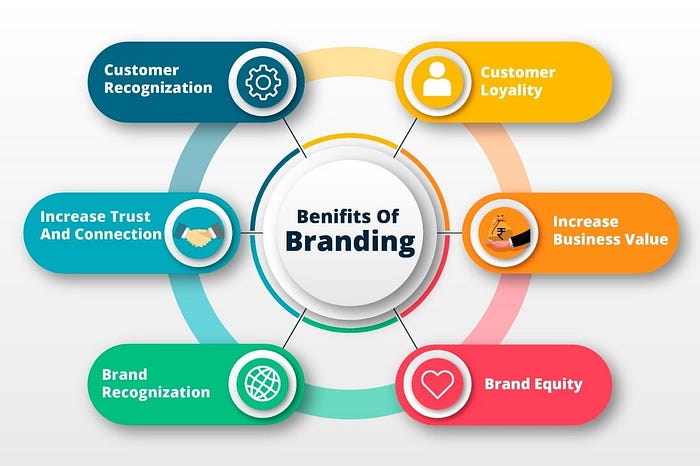Why is Branding important, and why is it so important for your business?

What is Branding?
Branding is a process of creating a strong, clear perception of the company. Basically, in the mind of customers to blend elements such as a logo, design, mission statement, and a consistent theme throughout all marketing communications. Originate brands differentiate themselves from their competitors and build loyal customer bases.
As Jeff Bezos says, “your brand is what other people say about you when you’re not in the room”. This quote means everyone has different logic for their brand. A valuable brand doesn’t need to cost you a million; it only requires a lot of creativity and research; in a recent study, 89% of people stay loyal to their brand, and they are strict with the brand and share similar values.
Based on the survey, 87% of consumers report that Branding globally is important, whether it’s all online or on any other traditional platform.
This means the customer assumes the tone of your voice is the same over the mail, website, service, and every other point of contact in your business. If you are thinking of rebranding, you need to work on it from logo to strategy and add some creativity to your theme while changing it from online to offline. Make sure you have to be consistent with your brand so that your customer will carouse with an omni-channel presence.
What is the importance of Branding?
Branding is key to a successful product, this can seem vague and complicated, but it is an important marketing concept and should be needed to understand. Everything related to your business and/or product is branded. From your brand story, it depends on how you communicate with clients or other users. Your brand represents the lifeblood of your business and everything it stands for. From day one, you must take Branding seriously and keep it in the forefront of your mind throughout your business’s successes and failures.
Here are some points that you need to build a strong brand
- Brand design (colors, palate, font, elements, packaging, themes, etc.)
- Social media presence
- Environment and company culture
- Product quality and pricing
- Website and marketing
- Taglines and slogans
- Customer service
Other factors that contribute to building a good brand include message, awareness, tone, philosophy, and overall personality of the business. Throughout the day, people are bombarded with millions of messages. You need good products, services, and a strong brand to stand out from the competition. It has been proven that a strong brand can advance a business far beyond its imagination.
Benefits of Branding

- Brand Identity –
Branding helps to create a recognizable identity. The moment someone sees any visual asset from your brand, whether a social media post, product packaging, a video ad, or an email, they will feel something. That “something” would be memorable and positive in an ideal world.
In interacting with your brand at multiple touchpoints, consumers will start forming an identity — which may or may not stick — creating that identity beforehand. Knowing that the consumer will receive small bits and pieces over time is the trick.
Their perceptions, ideas, and feelings about your brand begin with awareness, progress to preference, and finally lead to loyalty so long as their perception of your brand is positive and memorable.
- Customer Recognition –
In today’s world of ads, when a customer acknowledges a brand’s colour, theme, logo, etc., they prefer to choose that product over all others. Because they are already sociable with your brand and what it stands for. From something simple and modest to something wild and eye-catching, a good brand will consistently be recognized in a sea of others.
- Brand Management –
Brand management is the process of creating and sustaining your brand. It includes managing the tactile element of your brand (packaging, colour palette, style guide) and an impalpable element (how it’s visible to your target audience and customer base); your brand is a live feed asset it should be maintained.
- Brand Trust –
Brand trust stands for how strongly customers and consumers trust your brand. Do you deliver on your marketing promises? Do your salesperson and customer service go above and beyond? This kind of thing can build trust with your customer, which is important in the world because this 25% of people feel confident in a large business.
- Brand Valuation-
Brand valuation is the process valuation of your brand derived from consumer insight, recognition, and trust. This concept goes hand-in-hand with brand equity. A powerful brand can make your business invaluable to venture capitalists, shareholders, and prospective buyers.
Branding Terms to Know-
Since Branding is at its peak, there are a number of related terms that mean different things. Knowing these basic fundamentals will help along your branding journey. They include:
- Brand strategy
- Brand awareness
- Brand positioning
- Brand relevance
- Brand loyalty
- Brand equity
How to create a brand in 8 steps: –
“Creating a powerful brand involves a systemic process — from research to the creation of design implementation.”
If the process is not going through a systemic way you have to go back later to finish what you didn’t do in the first place.
Here are eight steps you can go along with this and build a brand of your own. We also included some detailed tips which can help you to implement.
Step 1: Audit & Research
The first process of creating a brand is doing research. If you’ve already been functioning without a genuine branding strategy, you’ll need to conduct a brand audit. These steps are significant for creating the first pillar of your Branding.
So, collect as much data as you can on your business, industry, and target audience. This particular fact will help you create a relevant and profitable brand in the long term.
Step 2: Create Customer Personas
A big part of doing research in the first step is collecting data on your target audience and understanding their demographics, needs, personalities, and motivations at a deeper level.
In this step, you’ll see all of this related information in an easy-to-take graphic or report called a customer persona.
A customer persona is also known as a user persona, buyer persona, or audience persona. They are essentially fictional characters or idealists who represent your target audience.
Step 3: Write Your Mission, Purpose, and Vision Statements
A mission statement is like a small paragraph describing a brand’s mission. A purpose statement describes its purpose, and likewise, the vision statement describes the brand vision.
Some brands use one or the other, and some use all of them… but what is the difference?
- The mission statement describes WHAT the brand does and for WHOM.
- The purpose statement elaborates WHY a brand does what it does.
- A clear vision of the brand’s future or where the brand is present.
Step 4: Establish Brand name and tone
At this point, you may or may not have your brand name.
Before choosing a name for your brand, consider the voice you will use to communicate, both internally and externally. Defining your brand voice will help you locate a good name that makes sense.
For example, ask yourself the following questions:
- Is my brand friendly and approachable or serious and respectful?
- Is my brand address the ideal customer directly or take a third-person approach?
- Does your brand use words that customers use regularly, or are you trying to avoid specific terms that other brands are already using heavily?
- Are you using the fear of FOMO angle, or are you using a more persuasive voice?
Another thing to consider while choosing a brand name is what you have planned for the future of your brand. Are you planning to grow in other areas? Or did you have any idea to offer different products later? Remember; The more distinctive your name, the more difficult it will be to branch out over time.
Step 5: Finalize Logo, Colors, and Imagery
With the name decided and the voice to match, it’s time to create the visual identity to represent your brand in front of customers.
This step primarily involves setting up your brand’s logo, colour palette, and imagery. These three things will directly affect the creation of your visual assets and marketing materials later on.
Step 6: Choose typography
The next step is the typography for your brand. This step is important because your choices will be on every piece of written or visual content that you share, both internally and externally.
Many brands don’t consider that brand font needs to be consistent across all of their customer touchpoints — from their website to social media to print assets and more. Typography is part of a brand’s visual identity, and when you change the font for every instance, your brand gets diluted.
To choose typography for your brand, you can use the same research you did for your logo and colors. Fonts have perceived personalities, and you can use them for your brand. You have to check out the 100 best fonts for brands.
When choosing typography, you have three main options:
- Utilize the Free Font from Google Fonts
- Buy a lifetime license for a more exclusive typeface that fewer brands will use.
- Choose the best typography designer to create a brand font just for you.
Whatever option you choose, make sure it aligns with your long-term brand goals and that your brand voice is measurable and suited to your budget.
Step 7: Build visual assets and marketing materials
Marketing is the vehicle for growing your brand, and Branding is the fuel.
Here are some names of the marketing work in business:-
- Business Card
- Letter Head
- Social Media Graphics
- Proposals
- Reports
- Invoices
Step 8: Apply your brand to all touchpoints
Finally, it’s time to ensure that every visual asset or marketing material created is always on brand and in line with your brand voice and values.
Ensure that your brand is front and center in the included visuals everywhere your brand interacts — from name tags to banners, social media bios, blog posts, employee handbooks, customer service systems, etc.
Your brand voice is vital to all communication, both internal and external. So, just as the copy on your social media posts should align with your core values, brand personality and voice, your customer-facing employees should deal with client interactions, complaints, demos, and emails.
Branding Tips to keep in your mind –
By following these procedures above, anyone can start a brand. But not every brand manages to outstrip the competition and become memorable. We’re here to help you to go the extra mile.
To help you grow your business and take your brand to the next level, here are some elements and best practices to consider as a brand manager. These dumps will help your team continue on brand and work together towards the same goal and vision.
- Create a brand style guide
- Save branded template for later use
- Measure Brand equity
Take Your Branding to the Next Level With PointOfViewer
Wow, you made it here! Good thing. How did you like our complete guide to Branding? Do you feel like you have a better grasp of Branding now?
Branding is one of our favorite topics here at PointOfViewer.
We love helping businesses to build their Brand or brand guides. They can highlight their assets to the employees or users so they will follow the same values. We created Pointofviewer to make it even easier to design your brand with a better point of view.
Are you curious to learn more about Branding with us? PointofViewer can help to build a powerful brand identity.
